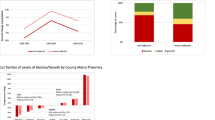Abstract.
The growth of small towns in Israel differs by location. Settlement pattern in a region is an important determinant: Isolated towns perform worse than those surrounded by other urban localities. The rates of growth of peripheral and centrally located towns converge in unfavourable economic years and diverge when the overall economic situation improves. This may be due to the interplay of two factors: the availability of employment and housing costs. In favourable economic years, migrants from peripheral towns move to central localities, attracted by employment opportunities. Concurrently, during periods of economic slow-down, when employment opportunities shrink, migrants may refrain from costly long-distance moves; some may even move to peripheral localities to minimize housing and other costs. The analysis covers 29 urban localities, most of which were established as new ‘development towns’ (DTs) in the late 1950s-early 1970s. The study focuses on three distinctive groups of development indicators – employment, population wealth, and migration, – and covers the period between 1970 and 1996. The findings lend support to the cluster-based strategy of regional development, according to which both the functionality and the growth potential of a small town may be enhanced by its location within a cluster of towns, situated within commuting distances from each other.
Similar content being viewed by others
Author information
Authors and Affiliations
Corresponding author
Additional information
The present research was conducted in the framework of the research project, entitled, ‘Success and Failure of Israel’s Development Towns: Does Location Matter?’ (A seed grant provided by the R&D Authority of the Ben-Gurion University of the Negev). In its shorter form, the paper was presented at the Annual Conference of the Israeli Geographical Association (Ben-Gurion University of the Negev, December 1–3, 2002). The author is grateful to Wolfgang Haller, the Desert Architecture Unit, and Moshe Schwartz, the Social Studies Unit, Jacob Blaustein Institute for Desert Research for their invaluable assistance in preparing the manuscript. The author’s gratitude is also due to three anonymous reviewers for their useful comments and suggestions.
Received: May 2002/Accepted: November 2003




